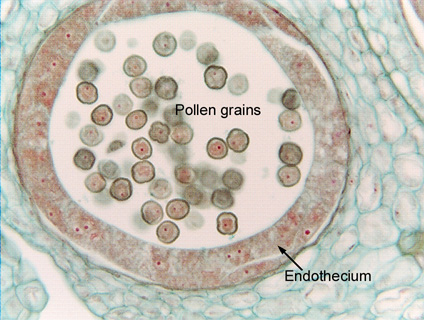 Fig.
9.3-9. Transverse section of stamen in lemon flower (Citrus limon).
This is a transverse section of the anther, the part of the stamen that actually
produces the pollen grains. As part of pollen development, the cells lining the anther lumen – a layer
known as the endothecium – secretes materials that are essential for the
proper maturation of the pollen grains. In many cases, secretory
processes in plants involve interaction with animals (deterring herbivores or
attracting pollinators), but in processes like this in the anther, the secretion
is a mechanism by which one part of a plant affects another part of the same
plant.
Fig.
9.3-9. Transverse section of stamen in lemon flower (Citrus limon).
This is a transverse section of the anther, the part of the stamen that actually
produces the pollen grains. As part of pollen development, the cells lining the anther lumen – a layer
known as the endothecium – secretes materials that are essential for the
proper maturation of the pollen grains. In many cases, secretory
processes in plants involve interaction with animals (deterring herbivores or
attracting pollinators), but in processes like this in the anther, the secretion
is a mechanism by which one part of a plant affects another part of the same
plant.